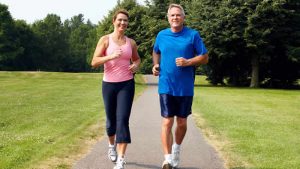How to run properly and injury free

Spring is in the air and peoples thoughts are turning to getting ready to show off your new beach body. Of course some form of exercise is needed to make that transformation. How better then pounding the pavement with a run! But before you dust off your trainers and shell suit. There are a few things you should consider.
If you are overweight, running will put pressure on your joints, especially the knees and ankles. Fast walking would be a better option to prepare you for running, it would also help to reduce your weight over time, and improve your stamina.
Using the right shoes is imperative! Running on anything other than running shoes is asking for trouble, in the form of injury or cramps, possibly muscle strain. You can go further and choose the right running shoe for your gait, i.e. if you have a raised arch in your foot you can find trainers that are specifically for you and if you’re arches are low or you are flat footed you can find trainers specifically designed for you too. This will make your running experience more comfortable and enjoyable.
Warming up and warming down are crucial to prevent injury and improve muscle performance. Warming up before running can be done in many different ways. I prefer to go through a dynamic stretching routine myself and with clients; stretching the major leg and hip muscles and lower back muscles, and after a run, we will go through a static stretch routine. This will help clear any lactic acid that has built up and will also improve your flexibility and muscle performance. Static Stretching while cold is not as effective as static stretching when warm, the muscles are more elastic when warm so they will respond better to stretching.
When starting out it may be better to train for time rather than distance, for example run for 10 minutes to begin with gradually increasing to 12 minutes and so on, this may be more effective than trying to run for a mile or half mile unsuccessfully.
Pace is important when distance running or when you are new to running. Often new runners will set off at a near sprint pace, which is unsustainable over a long distance: think of sprinters at the Olympics, they run for 100 meters, or at the most 400 meters. But you will notice the pace reduces as the distance increases unless you are Mo Farah, in which case you can sprint through a marathon, but athletes like Mo are elite distance runners and train intensively for that style of running. So for beginners running at a jogging pace or comfortable running pace would serve you much better to start off with.
Hydration is another important factor, often forgotten: before, during and after running, especially when distance running. Water will help muscle function, replenish the water you lose through respiration (breathing) and perspiration (sweating) it also aids chemical reactions in your body while you are running.
So, like many things, it is easy really, when you know how!
For any advice or if you have any questions regarding this post, please feel free to contact me at
andy@ai-total-fitness.com
